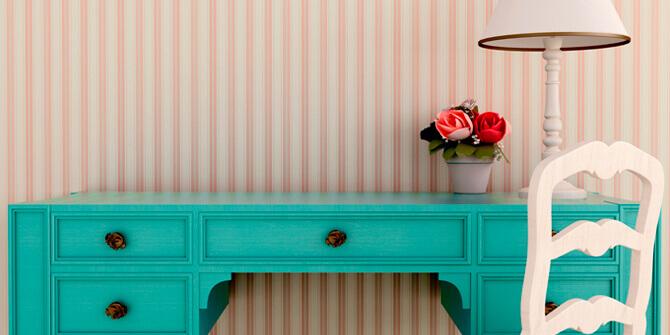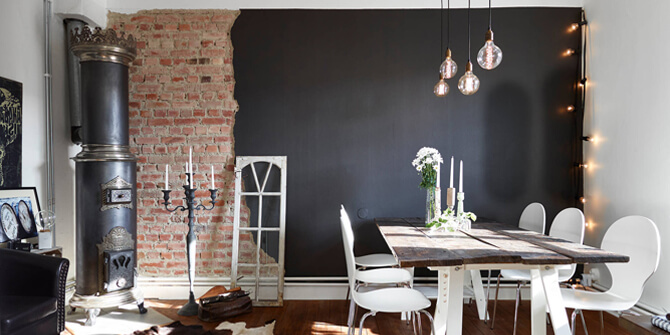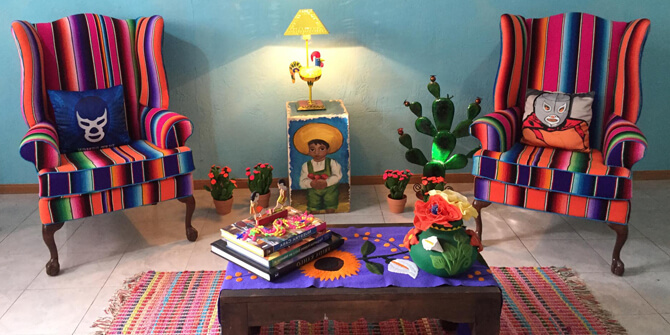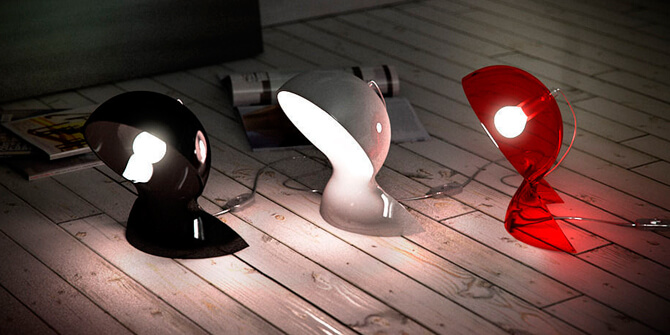In recent years, vintage and retro decorations have become a trend and have gained a lot of prominence in interior design. They are based on imitating or recreating the type of decoration used from the 20s to the 60s, with lots of colour, prints and a certain romantic air that is reminiscent of the golden age of Hollywood, which was in its peak during these decades.
We can see how vintage decoration has been gaining a lot of strength in recent times. Any relevant manufacturer we can think of has products focused on this type of decoration. As we have seen in other entries in this blog, opting for vintage and retro decorations is a safe bet when it comes to interior design.

Vintage decoration or retro decoration?
We’re going to talk about both vintage and retro decoration, but before getting into it, first we need to clarify the difference between them. Vintage decoration and retro decoration are similar yet different concepts.
Both the vintage and retro style are reminiscent of the past, however, the difference between the two is that vintage decoration is characterised by the use of original pieces that are many years old, while retro decoration is made up of current pieces with a style based on classic designs. For example, a lamp made in the 40s that you can find at your parents’ or grandparents’ house is a vintage lamp; a lamp made today but with a ‘50s style, like the Nesso by Artemide, for example, is a retro lamp.

There are also small differences between the vintage style and the retro style in the use of materials and colours, but they are not as significant or even as exclusive as the time characteristic is.
Materials and Colours
As if it were a blank canvas, when introducing vintage or retro-style decoration, the base colour used is white or off-white. It is also common to use wallpaper in pastel colours, which are a benchmark within these styles. On the other hand, when it comes to “painting the canvas” with accessories and furniture, bright colours or pastel colours are often used.
Aquamarine and coral are two colours that have become very popular, like the white or off-white we mentioned before. Floral patterns are protagonists and can be found on curtains, carpets, cushions, quilts …

Wood, wicker and wrought iron are the most commonly used materials when recreating the vintage style. In textiles, we can play with both natural and synthetic fibres. In contrast, the retro style is characterised by the use of metal, plastic, leather and vinyl materials.
Accessories
A key part to achieving a retro or vintage style interior design is the choice of accessories. In addition to looking for accessories that are or seem old, we will enhance the decoration if we manage to find accessories that are unique, special and/or recognisable.
For example, on the living room wall, we can place a large empire mirror, with an oval or rectangular shape; we could also hang old photographs on the wall with frames of different shapes, sizes and finishes; it is a very good idea to use flowers as they’ll help us to achieve the look we’re after with either a vintage or retro decoration: colour, freshness and romanticism.

We can also choose an old style faucet and even a bathtub with legs in the bathroom if we want to completely immerse ourselves in a vintage or retro style.
Use wall or rotary telephones, a turquoise French vase, empire paintings, antique perfume bottles, art deco lamps, wicker baskets, worn trunks, antique wall clocks, porcelain cups and plates… Accessories are as important as they are varied. Choosing them is an important task and the options are incredibly diverse. They will be in charge of immersing us in the environment we are looking for.

Advantages of Vintage/Retro Decoration
So far, we’ve briefly gone over what vintage and retro decoration is, but what advantages and disadvantages can help me to decide whether to incorporate these styles into my home?
The main advantage is that what’s old is new again, meaning our home can be trendy without needing to have the latest and greatest. In addition, decorating our home in this way will better stand the test of time, something that our wallets will appreciate.

Another great advantage is the current popularity of these styles. It will not be hard for us to find products that conform to what we’re looking for if we head to street markets, jumble sales, garage sales or even get our hands on an heirloom from an inheritance.
Another advantage of opting for a vintage or retro style is that it doesn’t require exhaustive studies in interior design. These styles are very open and free, and also go great in homes with children or teenagers. Even toys that stay on the floor can enhance the decor.
Disadvantages of Vintage/Retro Decoration
One big disadvantage of introducing these styles into our home is when we have to look for something specific. Just how it can be easy to find accessories or furniture in street markets and the like that fit the style we’re looking for, if we’re after something specific, then it can be very difficult to find it.
It can be especially frustrating to look for an original piece for our vintage decoration and never be able to find it.

Another drawback that relates directly to the exclusivity and originality of vintage products has to do with their popularity. That is, the increase in popularity of this type of decor means the pieces can be really expensive because some have practically become collector’s items. If we add to this the fact that most vintage items are already discontinued and that we have to go to individual sellers, antique dealers or auctions, then the prices can really skyrocket.
As a general rule, original pieces have many years of use and, although they can be in good condition and have been properly cared for, their quality will differ greatly from that of a new product. Therefore, some of the pieces that we need for our vintage decoration may need to be restored, which can mean a significant increase in the final price of the product.

It is increasingly difficult to find bargains among older products. With the growing popularity of the vintage and retro styles, people are becoming better informed and are increasingly aware of the value that our belongings can have. This means that the price of acquiring these products also continues to rise.
Main Styles in Vintage and Retro Decoration
Shabby Chic
The term Shabby Chic is composed of two almost antagonistic concepts; on the one hand, we have the word shabby that means worn or dishevelled and, on the other, the term chic that means elegant, distinguished or fashionable. That’s why this style of decoration is characterised by the use of old elements with other more modern ones.
White is the predominant colour. It is used both on the walls, to give a sense of spaciousness to the rooms, as well as in the decor. Apart from white, pastel colours such as pale pink, aquamarine, light blue, beige, etc. are also used. If we use light tones, we avoid darkening the rooms. What we try to achieve by avoiding flashy colours or elements is to give the rooms a feeling of calm, harmony and peace.

In romanticism, there is a predominance of warm and welcoming ambiences that inspire peace and quiet; therefore, as we’ve seen, Shabby Chic is a romantic style of interior design.
This romantic style of decoration uses wood as the main, almost essential material for the furniture in the home. In hallways, on desks, bedside tables, shelves, kitchen furniture, etc. that follow a Shabby Chic style, wood will be a predominant material, always with a natural and sometimes aged appearance.

Industrial Style
When referring to an industrial style, also known as an urban style, we’re talking about a style of interior design whose origins come from the typical architecture found in factories from the 50s and the industrial style of that time. Back then, American youth had to adapt the large and spacious factories to be able to live in them. This meant that a space full of beams, bricks and concrete walls had to be adapted to its new use as a home.
The main characteristics of this style is focused on having wide, open and bright spaces, with large windows that let the light shine through. When it comes to colour, white is permitted as the light shade of colour par excellence, but the colours that predominate and characterise this style are darker, such as earth tones, beige, grey, brown, navy and electric blue. Although black can also usually be found, we tend not to overdo it since what we’re looking for is to create the feeling of spaciousness.

To create a fully industrial style, we’ll have to strip the structure of its materials and the home through the use of visible pipes, wrought iron furniture with a little rust, visible ceiling beams with a worn appearance, uncovered natural wood, sheet metal and iron, and an endless number of other possibilities.
The most frequently used elements are iron and steel. These materials predominate on walls, ceilings, and even on chairs, tables, shelves, and in all kinds of decorative elements and accessories. These materials are usually accompanied by wood, since it provides the warmth that the other two lack.
If we manage to find a balance when combining the different elements, success is guaranteed. The warmth of the wood and the brightness of the large windows, coupled with the aged and dirty appearance of the characteristic objects of an industrial style, make it an ideal environment for people who prefer a more urban ambience.

Kitsch or Pop Art Style
The Kitsch or Pop Art style is characterised by messiness, a mash up and extravagance, it means “more is more” and anything goes with this style, or almost anything.
A Kitsch or Pop Art style breaks away from the hegemony of white, cold and impersonal rooms, giving way to the extravagant and flashy. In this style, the protagonists are the seemingly anti-aesthetic and out of place colours, shapes and elements. It’s important to know how to differentiate this style from a modern style, since Kitsch mixes textures and materials, while a modern look is based on simple lines with bright and ample spaces.

Kitsch is a style that has been very successful since it caught the attention of many different types of people and, above all, because the room itself stands out and demands our interest even with the smallest details. Although it was described as an art that did not change and was formally incoherent, it is a fun and colourful style and allows the same room to include many different decorative elements and styles. The overall picture or the final result don’t matter, since it focuses on individually highlighting specific objects, colours or textures.
In Pop Art, we go for colour: apple green, bubble gum, sky blue and red are the four most characteristic tones. There is also a plethora of different textures, shades, fabrics, furniture and objects that step outside the boundaries of formality. When decorating our house, the limits of this style are only in our imagination, it’s all about having fun. This peculiar style is based on decorating the home and having fun, without placing too much importance on the reason for why things are done. The only limits are in our imagination.

In every self-respecting Kitsch or Pop Art space, there always has to be an area dedicated to displaying souvenirs, figurines, plates, cups… Any collection we want to exhibit must complement our Kitsch-style room, regardless of whether it’s consistent with the rest of the decorative elements, here what matters the most is what we want to convey, something that’s part of ourselves.
Selection of Retro Style Lamps by ilutop
Dalu Collection by Artemide

Ventopop Collection by Arturo Álvarez

Aitana Collection by Carpyen

Emma Collection by Estiluz

Tavern Collection by Faro Barcelona

Snoopy Collection by Flos

Snoopy Collection by Flos

Vintage Collection by Leds C4

Ginger Collection by Marset

Pamela Collection by Metalarte






Qué pasada el salón con los cuadros Andy Warhol. Aunque me sigo quedando con el estilo industrial, es espectacular!
Gracias por el artículo.
Muchas gracias por su comentario!
Hoy en día cada estilo de decoración trae consigo una multitud de opciones y variantes que lo hacen espectacular.
¡Un saludo!